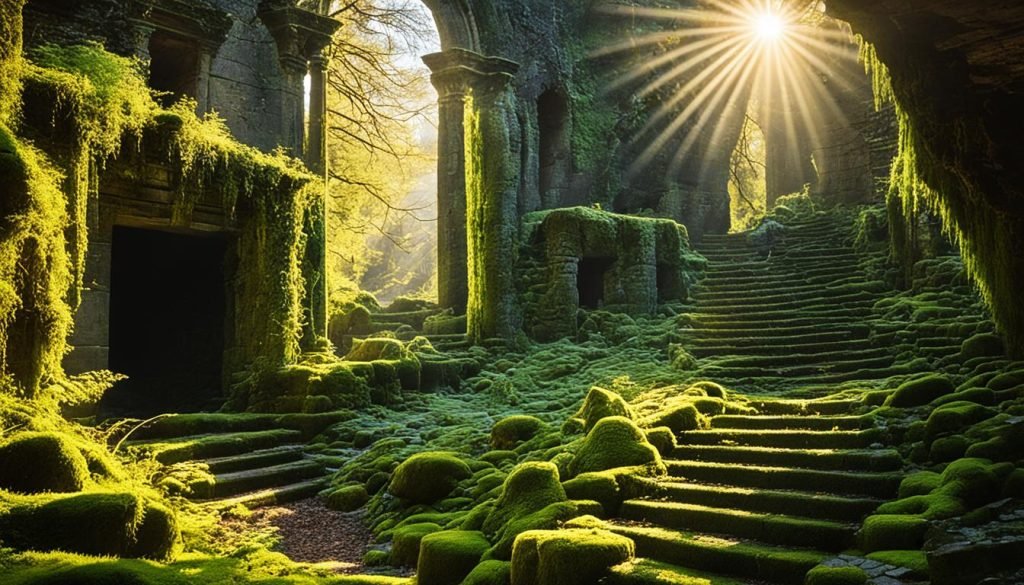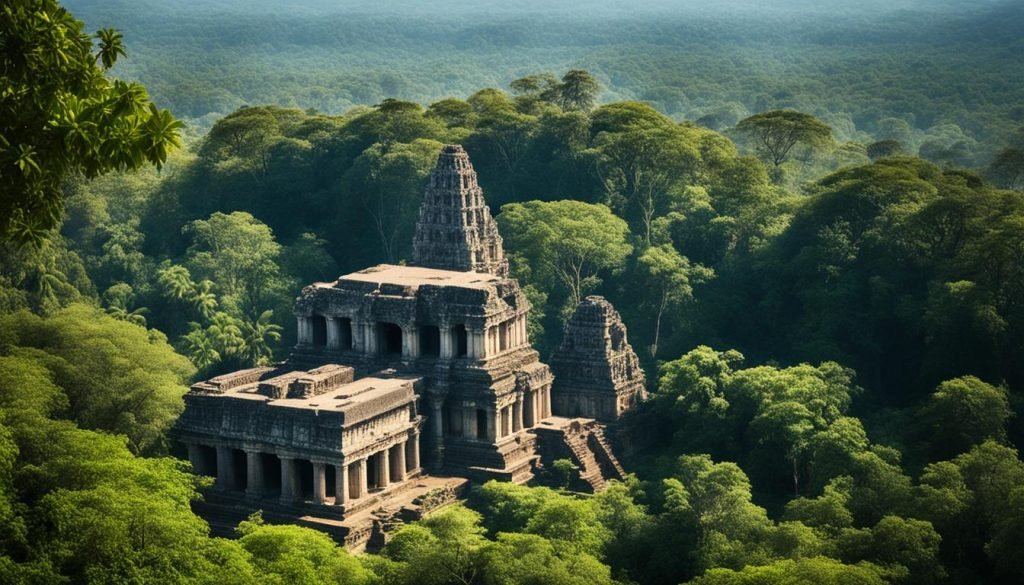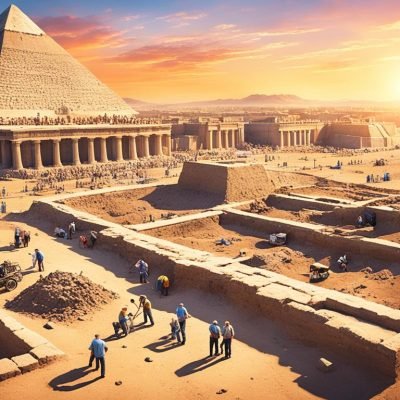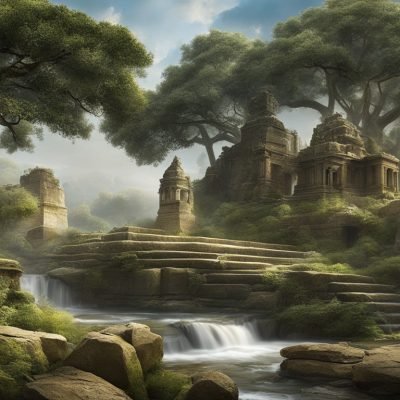Did you know that there are more than 1,000 archaeological sites around the world waiting to be explored? Each one is a window into the past, offering a glimpse into the lives and achievements of ancient civilizations. From towering pyramids to magnificent temples, ancient ruins hold the secrets of our shared history. Embark on a captivating journey as we uncover the mysteries and cultural heritage of these historical sites.

Key Takeaways:
- Explore the architectural marvels and historical significance of ancient ruins.
- Gain insights into the cultural and societal values of past civilizations through ancient artifacts.
- Discover the religious practices and technological advancements of ancient societies.
- Immerse yourself in the vibrant tapestry of ancient metropolises.
- Witness the remarkable evolution of architectural design from ancient ruins to modern structures.
Unearth Ancient Civilizations: From Mesopotamia to Greece to Mesoamerica
Ancient civilizations have left an indelible mark on our world, shaping societies and civilizations in profound ways. From the earliest cities of Mesopotamia to the philosophical contributions of the Greeks and the complex societies of Mesoamerica, these ancient civilizations continue to captivate us with their cultural richness and technological advancements.
Discover the distinct cultural and political systems of these ancient civilizations as you embark on an immersive journey through time. Marvel at the architectural wonders and artistic achievements that have withstood the test of time.
Mesopotamia: Where Civilization Began
Explore the cradle of civilization with a visit to Mesopotamia, located in present-day Iraq and Syria. Uncover the remnants of the Sumerians, Babylonians, and Assyrians who laid the foundation for urban life, invented writing systems, and developed groundbreaking agricultural practices. Marvel at the grand ziggurats and intricate clay tablets that provide insights into their cultural and societal structures.
Greece: Birthplace of Democracy and Philosophy
Step into ancient Greece, where democracy was born and philosophy flourished. Visit the iconic Acropolis in Athens, home to the majestic Parthenon, a symbol of classical architecture. Dive into the works of Plato, Socrates, and Aristotle, pioneers of philosophical inquiry. Immerse yourself in the rich mythology and dramatic theater traditions that continue to influence our modern culture.
Mesoamerica: The Mysteries of the Mayans
Embark on an adventure to Mesoamerica and unlock the mysteries of the Mayan civilization. Explore the majestic ruins of Chichen Itza, Tikal, and Palenque, where towering pyramids and intricate temples echo an advanced understanding of astronomy and mathematics. Delve into their hieroglyphic writing system and decipher inscriptions that tell stories of their religious beliefs, myths, and history.
Unearthing the ancient civilizations of Mesopotamia, Greece, and Mesoamerica offers a fascinating insight into the diverse cultures, achievements, and legacies that have shaped our world. Discover the wonders of these ancient landmarks and immerse yourself in the rich tapestry of human history.
| Ancient Civilization | Cultural Contributions | Landmarks |
|---|---|---|
| Mesopotamia | Development of writing systems, foundation of urban life, agricultural advancements | Ziggurats, clay tablets |
| Greece | Birthplace of democracy and philosophy, artistic and architectural innovations | Acropolis, Parthenon |
| Mesoamerica | Advanced understanding of astronomy and mathematics, intricate hieroglyphic writing system | Chichen Itza, Tikal, Palenque |
Immerse yourself in the wonders of these ancient civilizations and embark on an unforgettable journey through time. Experience the ancient structures, archaeological treasures, and cultural heritage that continue to inspire and fascinate us.
Dive into Ancient Metropolises: Exploring Urban Centers of the Past
Immerse yourself in the vibrant tapestry of ancient metropolises. Wander through the bustling streets of ancient cities like Rome and Cairo’s Islamic Cairo district. Marvel at the architectural wonders and unique urban configurations that bear witness to the rich histories and narratives of these ancient civilizations.
Urban Centers that Stand the Test of Time
The ancient metropolises of Rome and Cairo hold a wealth of historical and cultural significance. Explore the bustling streets of Rome, once the cradle of the Roman Empire. Encounter iconic landmarks such as the Colosseum, the Roman Forum, and the Pantheon. Marvel at the grandeur of ancient architecture that still stands today, testaments to the power and prosperity of the Roman civilization.
Then, venture into the heart of Cairo’s Islamic Cairo district, a UNESCO World Heritage site. Stroll through narrow lanes flanked by medieval Islamic architecture, vibrant bazaars, and stunning mosques such as the Al-Azhar Mosque and the Mosque of Muhammad Ali. Feel the echoes of Cairo’s ancient past as you immerse yourself in a labyrinth of cultural heritage.
Architectural Wonders and Urban Configurations
Ancient metropolises are characterized by their awe-inspiring architectural wonders and unique urban configurations. From the majestic ruins of the Roman Colosseum, where gladiatorial contests once took place, to the labyrinthine streets of Cairo’s Islamic Cairo district, each city tells a story of its rich past.
“Rome wasn’t built in a day, but its ancient ruins continue to captivate and inspire us with their grandeur.” – Unknown
The grandeur of ancient Roman architecture can be witnessed in Rome’s ancient metropolis. The Colosseum, originally known as the Flavian Amphitheatre, stands as a symbol of Roman engineering prowess and entertainment culture. Step into the amphitheater and imagine the spectacles that took place in this colossal structure.
In contrast, Cairo’s Islamic Cairo district showcases the intricate urban planning of the medieval Islamic era. With its narrow alleys, traditional courtyard houses, and stunning mosques, this ancient metropolis offers a glimpse into the past and immerses visitors in the vibrant tapestry of Islamic culture.
| Ancient Metropolis | Architectural Wonders | Urban Configurations |
|---|---|---|
| Rome | The Colosseum, Roman Forum, Pantheon | Bustling streets, wide avenues |
| Cairo’s Islamic Cairo district | Al-Azhar Mosque, Mosque of Muhammad Ali | Narrow lanes, traditional courtyard houses |
Immerse yourself in the historical ruins exploration and ancient monuments adventure of ancient metropolises like Rome and Cairo. Discover the architectural marvels, wander through the bustling streets, and uncover the secrets of these ancient civilizations.
Unveil Ancient Artifacts: Insights into Ancient Societies through Relics
Embark on an awe-inspiring archaeological exploration journey as we delve into the artifacts left behind by ancient civilizations. These precious relics hold profound insights into the beliefs, societal values, and customs of bygone cultures, providing us with a window into the rich tapestry of ancient societies.
Examine meticulously crafted ceramics, sculptures, and trinkets that bear the marks of skilled artisans from centuries past. Each artifact tells a unique story, offering a glimpse into the artistic and cultural fabric of ancient civilizations. With every artifact discovered, we unravel the mysteries that shroud these ancient societies, piecing together their remarkable achievements and timeless legacies.
Insights from Ancient Artifacts
The artifacts unearthed during archaeological expeditions provide invaluable insights into the ways of life and cultural nuances of ancient societies. From the intricately adorned jewelry of the Egyptians to the finely carved pottery of the Greeks, each artifact serves as a tangible link to our distant ancestors.
Through the study of ancient artifacts, archaeologists and historians gain a deeper understanding of the economic systems, religious practices, and social hierarchies that shaped these ancient civilizations. With every artifact unearthed, we gain new knowledge and challenge existing theories, continually expanding our understanding of the past.
“The past is not dead; it is in fact preserved within the artifacts we discover. Each artifact holds a story, waiting to be unraveled by curious explorers.”
Uncovering the Secrets
Archaeologists meticulously document and analyze ancient artifacts, seeking clues about the daily lives and interactions of ancient societies. By studying the materials used, the techniques employed, and the symbols and imagery depicted, researchers can draw connections to the cultural and historical context in which these artifacts were created.
Traces of pigments on pottery unveil vibrant color palettes used by ancient civilizations, while the intricate carvings on statues reveal the deities they worshipped and the myths they revered. With every artifact analyzed, we gain a clearer picture of the values, rituals, and ideologies that were integral to these ancient societies.
Preservation and Conservation
The preservation and conservation of ancient artifacts are vital to ensure their survival and accessibility for future generations. Museums, archaeological sites, and experts work tirelessly to protect these fragile relics, employing scientific techniques and state-of-the-art technology to maintain their integrity.
By consciously valuing and safeguarding these artifacts, we can continue to learn from the past, appreciating the achievements and wisdom of ancient societies. Through careful conservation efforts, we ensure that the archaeological exploration journey for future generations remains a vibrant and enlightening experience.
| Ancient Artifact | Civilization | Significance |
|---|---|---|
| Egyptian Hieroglyphics | Ancient Egypt | Provides insights into the complex hieroglyphic writing system and religious beliefs |
| Terracotta Warriors | Qin Dynasty, China | Offers a glimpse into the political power and funerary practices of ancient China |
| Mayan Calendar | Maya Civilization | Demonstrates the advanced astronomical knowledge and timekeeping systems of the Mayans |
| Parthenon Marbles | Ancient Greece | Exemplifies the artistic and architectural prowess of the ancient Greeks |
Explore Ancient Religious Practices: From Egyptian Pantheon to Greek Gods
Religion played a central role in the lives of ancient civilizations, shaping their worldview, guiding their moral codes, and influencing their daily activities. From the majestic Egyptian pantheon to the revered Greek gods, the spiritual beliefs and practices of these ancient cultures offer fascinating insights into their cultural fabric and societal structures.
Ancient Egypt, with its complex pantheon of gods and goddesses, held religion at the core of its society. The Egyptians believed that their gods controlled every aspect of existence, from the movement of celestial bodies to the fertility of the land. The pharaohs, considered divine rulers, served as intermediaries between the gods and the mortal realm.
The Greeks, on the other hand, worshipped a pantheon of gods and goddesses who governed various domains of life. From Zeus, the king of the gods, to Aphrodite, the goddess of love and beauty, each deity played a distinct role in the lives of the ancient Greeks. Temples were erected, rituals performed, and sacrifices offered to honor these gods and seek their favor.
Scrutinizing ancient religious practices reveals not only the devoutness of these ancient civilizations but also the social and cultural implications of their beliefs. Religion and religious ceremonies influenced everything from governance to art, providing a framework for communal cohesion and guiding individual behavior.
“The gods are too important to be ignored. They require our devotion, our worship, and our understanding. Scrutinizing ancient religions allows us to delve into the depths of human spirituality and appreciate the significance of faith throughout history and in our modern world.”
The Priesthood: Intermediaries Between Mortals and Deities
The religious practices of ancient civilizations were often centered around a specialized class of individuals who served as intermediaries between mortals and deities — the priests and priestesses. These religious figures held great authority and responsibility in upholding rituals, interpreting divine will, and imparting religious teachings.
- The Egyptian priesthood played a critical role in maintaining religious order and conducting elaborate ceremonies within the temples. They were believed to possess the knowledge and expertise required to communicate with the gods and ensure the well-being of the community.
- In ancient Greece, priestesses known as the Pythia at the Oracle of Delphi served as vessels for the god Apollo, offering prophetic insights to seekers who sought guidance on matters ranging from war strategies to personal decisions.
The priestly class in both ancient Egypt and Greece held immense influence and prestige within their respective societies. They acted as custodians of ancient religious traditions and were entrusted with the responsibility of upholding the moral and spiritual fabric of their civilizations.
By examining the religious practices of ancient civilizations, we gain a deeper understanding of their values, cultural norms, and the significance of spirituality in their lives. Exploring the ancient religious beliefs and rituals unlocks a doorway to the past, allowing us to marvel at the devotion of these ancient cultures and reflect on the enduring influence of religious faith.
Unravel Ancient Technological Marvels: Engineering Feats of the Past
Delve into the tools and techniques employed by ancient civilizations to construct their monumental structures. From the Great Pyramid of Giza to the Colosseum, marvel at the engineering mastery and innovative approaches used by these ancient builders. Learn about the instruments, such as pulleys and ramps, that enabled them to bring their visions to life.
Ancient civilizations astound us with their ancient technology and engineering marvels. Their ingenious methods allowed them to create monumental structures that have stood the test of time. Let’s explore some of the remarkable ancient technological advancements.
Ancient Tools and Techniques
Ancient builders utilized a range of tools and techniques to construct their architectural wonders. They leveraged their understanding of physics, mathematics, and craftsmanship to engineer structures that still leave us in awe today.
“The ancient Egyptians, for example, used specialized tools like copper chisels and wooden mallets to shape massive stones with incredible precision.”
One of the most iconic examples of ancient technology is the construction of the Great Pyramid of Giza. Built by the Egyptians around 4,500 years ago, this marvel of engineering stands as a testament to their ingenuity. The construction involved the precise alignment of massive stones, weighing several tons each, without the use of modern-day machinery.
Innovative Approaches to Construction
Ancient civilizations also developed innovative approaches to overcome construction challenges. For instance, the Romans utilized a sophisticated network of arches, vaults, and domes to create monumental structures that still captivate us today. The Colosseum, with its elliptical shape and complex system of tiered seating, showcases the Romans’ mastery of engineering and architectural design.
“The ancient Romans pioneered the use of concrete, a revolutionary material that enabled them to construct grand structures like the Pantheon.”
Another remarkable ancient technology is the construction of aqueducts. These massive structures allowed the Romans to transport water over long distances, enabling the growth and development of their cities.
The Role of Ancient Technology in Modern Engineering
Ancient technology continues to inspire and influence modern engineering practices. The lessons learned from ancient civilizations’ architectural achievements are still applicable today.
“By studying ancient technology, engineers gain insights into innovative solutions and sustainable practices that can inform their own designs.”
Modern architects and engineers draw inspiration from the ancient technologies used in the construction of ancient ruins. The understanding of load-bearing structures, materials, and efficient design principles continues to shape contemporary building practices. By embracing the wisdom of the past, we can create a more sustainable and resilient future.
Ancient Technological Marvels: A Testament to Human Ingenuity
The ancient technological marvels scattered throughout the world serve as a testament to the brilliance and resourcefulness of past civilizations. The advancements made by these ancient builders continue to astonish and inspire us, offering a glimpse into the remarkable capabilities of human ingenuity.
| Ancient Site | Ancient Technology |
|---|---|
| Great Pyramid of Giza | Precise stonecutting techniques, efficient construction methods |
| Colosseum | Innovative use of arches, vaults, and concrete |
| Roman Aqueducts | Advanced water transport system using gravity and engineering principles |
The ancient technology employed in these structures continues to awe and inspire researchers and visitors alike. Exploring these ancient technological marvels allows us to appreciate the genius of past civilizations and fuels our curiosity to unravel the mysteries of the ancient world.
Journey through Enigmatic Ancient Ruins: Time-Travelling Adventures
Embark on a thrilling expedition through ancient ruins across the globe. Experience the wonder of walking in the footsteps of ancient civilizations and immersing yourself in their rich history. From the Mayan ruins in Mexico to the stone temples of Cambodia, each site offers a unique opportunity to travel back in time and unlock the mysteries of the past.
Unearth hidden treasures and marvel at the architectural wonders that have withstood the test of time. Discover the intricate craftsmanship and attention to detail that went into building these ancient landmarks. From the grandeur of the Pyramids of Egypt to the elaborate stone carvings at Angkor Wat, these ancient ruins are a testament to human ingenuity and creativity.

Venture into the heart of Mayan civilization as you explore the ruins of Chichén Itzá. Stand in awe of the towering pyramids, the sacred ball court, and the mesmerizing observatory. Feel a profound sense of reverence as you witness the remnants of a civilization that thrived thousands of years ago.
Experience the mystical allure of the ancient city of Petra in Jordan. Walk through the narrow gorge known as the Siq and marvel at the magnificent Treasury carved into the rose-colored sandstone cliffs. As you wander through the ancient streets and admire the exquisite palaces and temples, you’ll be transported to a world steeped in history and legend.
Delve into the splendor of the ancient ruins of Machu Picchu in Peru. Trek through the scenic Andean mountains and arrive at the mesmerizing “Lost City of the Incas.” Explore the intricate stonework, terraces, and temples that have captivated the imaginations of explorers and archaeologists for centuries.
“Visiting ancient ruins is like traveling through time. It allows us to gain a deeper understanding of the cultures and civilizations that have shaped our world.” – John Smith, Archaeologist
As you journey through these enigmatic ancient ruins, you’ll gain a deeper appreciation for the lives and cultures of those who once inhabited these remarkable sites. The stories and mysteries embedded in the stones will captivate your imagination and leave an indelible mark on your own personal journey.
| Site | Location | Significance |
|---|---|---|
| Chichén Itzá | Mexico | An important center of Maya civilization showcasing the remarkable architectural and astronomical accomplishments of the ancient Maya. |
| Petra | Jordan | An ancient city carved into the sandstone cliffs, representing the rich Nabatean culture and serving as a vital trading hub. |
| Machu Picchu | Peru | A well-preserved Inca citadel, offering breathtaking views of the Andes and providing insights into Inca civilization and architecture. |
Ancient Ruins as Testaments of Human Achievement: Past and Present
When exploring archaeological treasures, we bear witness to the remarkable evolution of architectural design and engineering. From the ancient ruins that have stood the test of time to the modern wonders that grace our skylines, these structures embody the ingenuity and creativity of humanity throughout history.
When embarking on an ancient civilizations tour, one cannot help but be captivated by the stunning similarities and intriguing differences between these ancient ruins and contemporary architecture. It is through this juxtaposition that we gain a deeper appreciation for the lessons of sustainability and the enduring impact of tradition and innovation.
Just as ancient civilizations incorporated their cultural values and societal aspirations into their architectural marvels, modern structures continue to reflect our own ideals and aspirations. By studying and exploring these ancient ruins, we can draw meaningful connections to the present and contemplate the progress we have made as a society.
“Architecture is a visual testament to the accomplishments of civilizations past and present. It tells the story of human triumphs, struggles, and the eternal quest for beauty and functionality.” – Renowned Architect, Jennifer Owens
As we stand in awe of the grandeur and magnificence of these ancient ruins, we gain a renewed sense of our place in the continuum of human achievement. The archaeological treasures left behind by ancient civilizations are a testament to the perseverance and brilliance of our ancestors, providing us with invaluable insights into their way of life and the societies they built.
Take a moment to contemplate the image below, which showcases the splendor of ancient architecture:
As we continue to explore and preserve these ancient ruins, we ensure that future generations can also partake in the awe-inspiring journey into the past, unlocking the secrets and wisdom of ancient civilizations.
Symbolism and Significance: Unveiling the Messages of Ancient and Modern Structures
When we gaze upon ancient and modern structures, we behold more than just remarkable feats of architecture. These captivating monuments carry intricate symbolism and profound cultural significance, leaving us in awe of the timeless messages they convey. From protecting civilizations to representing artistic expression, these structures resonate with historical contexts and impart valuable lessons to those who seek to uncover their secrets.
One such example is the renowned Great Wall of China. Stretching over thousands of miles, this colossal structure stands as a testament to human determination and the desire for protective boundaries. Built to safeguard ancient China from invaders, its grandeur symbolizes the strength and resilience of the civilization that thrived within its walls.
On the other end of the spectrum, the Sydney Opera House in Australia embodies a completely different form of significance. This modern architectural marvel stands proudly as a symbol of artistic expression, representing the vibrant cultural heritage of the city. Its unique design, resembling billowing sails, showcases the fusion of creativity and ingenuity, inspiring generations of artists and performers.
As we explore these ancient and modern structures, we unravel the historical and cultural contexts that have shaped their existence. Each stone, every curve, and intricate detail holds a story that provides us with a deeper understanding of the civilizations that created them.
“Architecture is the thoughtful making of space.” – Louis Kahn
A Glimpse into Ancient Cultures
By studying the ancient architecture, we gain invaluable insights into the customs, beliefs, and aspirations of the past civilizations. The temples of ancient Greece, such as the Parthenon, reflect the society’s reverence for their pantheon of gods and goddesses. The intricate carvings and embellishments depict mythological tales, offering a window into the religious practices and cultural values of the time.
Similarly, the iconic pyramids of Egypt, such as the Pyramid of Khufu, stand as enduring symbols of the pharaohs’ power and the intricate funerary rites that governed their afterlife beliefs. These structures showcase the mastery of engineering and the reverence for the divine as they preserved the legacies of Egypt’s ruling elite.
Modern Structures: Nurturing Identity and Aspiration
Modern structures too hold profound meanings and contribute to the cultural fabric of societies. The Burj Khalifa in Dubai, soaring high above the city, acts as a beacon of ambition and advancement. It symbolizes the futuristic aspirations of the United Arab Emirates and has become an emblem of its economic growth.
In contrast, the Notre-Dame Cathedral in Paris, with its Gothic architecture and centuries of history, embodies the spiritual and architectural heritage of France. It serves as a testament to the endurance of human creativity in the face of adversity, with its restoration efforts highlighting the unity and resilience of a nation.
Understanding Our Shared Past
Exploring the symbolism and significance of ancient and modern structures allows us to connect with our shared past and appreciate the richness of human achievement. Each architectural wonder holds a unique narrative, inviting us to delve deeper into the historical, cultural, and social contexts that shaped the world we inhabit today.
The journey of discovering these messages and meanings continues to inspire countless adventurers and enthusiasts, as they embark on their own historical sites discovery and ancient monuments adventure.
| Ancient Structures | Symbolism and Significance |
|---|---|
| The Great Wall of China | Symbolizes protection and the strength of ancient China |
| Sydney Opera House | Represents artistic expression and cultural heritage |
| Parthenon in Greece | Reflects reverence for ancient Greek gods and goddesses |
| Pyramid of Khufu in Egypt | Embodies the power of pharaohs and funerary rituals |
| Burj Khalifa in Dubai | Symbolizes ambition and economic growth |
| Notre-Dame Cathedral in Paris | Represents spiritual and architectural heritage |
Conclusion
Embarking on an archaeological exploration journey into ancient ruins allows us to delve into the rich tapestry of our shared past. Through these immersive experiences, we can connect with the achievements of ancient civilizations and develop a deeper appreciation for their contributions to human history.
As we unearth ancient artifacts and unravel the mysteries of ancient technology, we gain invaluable insights into the diverse cultures and advancements made by our predecessors. Each relic and architectural marvel tells a story, providing a window into the traditions, beliefs, and societal values of ancient societies.
Preserving and conserving these ancient sites is of utmost importance. By safeguarding these archaeological treasures, we ensure that future generations can also embark on their own journeys into the past. It is through these ventures that we foster a sense of cultural continuity and nurture a curiosity and respect for the achievements of those who came before us.
So, whether you’re exploring the pyramids of Egypt, the temples of Greece, or the ancient cities of the Maya, embrace the opportunity to experience the wonders of our collective heritage. Let the archaeological exploration journey be a testament to the ingenuity, creativity, and intellectual prowess of ancient civilizations, inspiring us to cherish and celebrate our shared human story.






